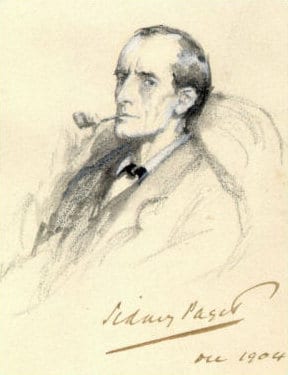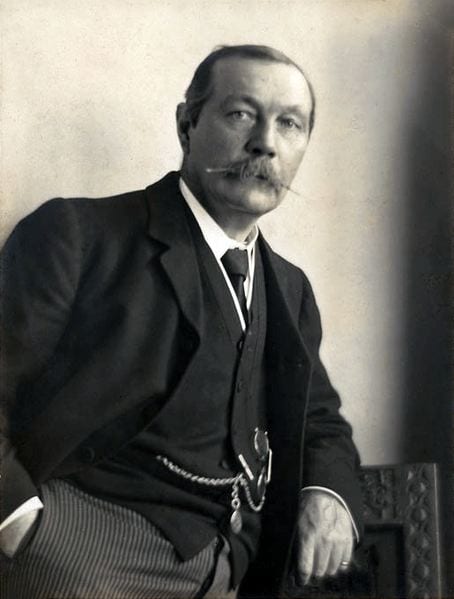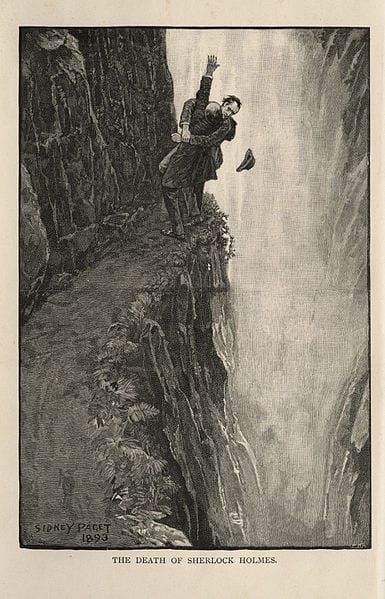Being reluctant to read Arthur Conan Doyle’s Sherlock Holmes stories after watching the different movie and TV adaptations, I now appreciate how amazing his stories are and how they’ve withstood the test of time.
About Sir Arthur Conan Doyle And Sherlock Holmes
Sherlock Holmes wasn’t the first fictional detective but he is the “most portrayed movie character” in history. The Sherlock Holmes stories have had a profound and lasting effect on mystery writing and popular culture.
Sir Arthur Conan Doyle, who wrote the Sherlock Holmes stories, has been credited as an influence to forensic science as a result of Holmes’ use of methods such as fingerprints, trace evidence, serology, ciphers, and footprints long before they were commonly used by the police.

From Humble Beginning
The first Sherlock Holmes story, “A Study in Scarlet”, first appeared in print in 1887 after it was rejected by about five publishers. It was finally accepted by Ward, Lock & Co, who specialized in cheap and often sensational literature, for £25 for the copyright.
The book was published in Benton’s Xmas Annual of 1887 and Arthur Conan Doyle never received any further money from the sale of the book. His follow up Holmes novel, “The Sign of Four”, published in 1890 fared slightly better but it wasn’t until Conan Doyle published Holmes as a series of short stories in The Strand magazine did he go onto to become a popular author — and the highest paid of his time.
Watch Treasures of the Sherlock Holmes Collections to see an original copy of “A Study in Scarlet” and to learn more about The Strand Magazine.
Practice and Persistence
Sir Arthur Conan Doyle’s story is no different from others that go on to achieve greatness in any field — science, engineering, sports, or the arts; it’s more about practice and persistence than innate talent.

Conan Doyle’s literary journey didn’t start with his Sherlock Holmes stories and he didn’t give up when his stories or novels weren’t received as well as he would have liked.
This is why he continues to inspire new generations 88 years after his death and 131 years after the first Sherlock Holmes novel was published.
Impact of Sherlock Holmes’ Death
On a side note, Sir Arthur Conan Doyle says in his memoirs that,
If I had never touched Holmes, who has tended to obscure my higher works, my position in literature would … be a more commanding one.
Conan Doyle even killed off Holmes in the “Final Problem” published in The Strand Magazine in December 1893.
Tired of writing about Holmes, he wanted to focus on writing what he considered more serious literature. On a practical level, writing out twelve short stories, each with unique plots, in a year would have been hard work.

His fans weren’t happy — more than 20,000 Strand readers canceled their subscription, outraged by Holmes demise.
Eight years later, in 1901, he published “The Hound of Baskerville” as a serial in The Strand Magazine set before Holmes dies in the “Final Problem” and in 1903 he resurrected Holmes in “The Adventures of the Empty House”.
Serialization of “The Hound of Baskerville” in 1901-1902 was estimated to have increased the magazine’s circulation by 30,000 — with Conan Doyle being paid £480 – £620 per episode.
Becoming a Writer
The Doyle family was fairly well-to-do but Arthur Conan Doyle was brought up in limited means. His father worked as a civil servant in Edinburgh with limited income with a large family. He was one of ten children, three of which died young, and one of two boys. His father was an alcoholic who spent time inside institutions. His sisters went out to work as governess oversees at a young age and would send their salary home to help support the family. During his early years he was an avid reader.
His mother sent him away to boarding school when he was ten.
He started writing while studying to be a doctor. A friend remarked that his letters were very vivid and surely he could write some things to sell. His friends remark took him by surprise since as an avid reader he never dreamt he could produce decide decent prose.
However, he decided to give it a try and wrote an short adventure story which was accepted by Chambers Journal for three guineas. While trying to establish himself as a doctor he continued to contribute several stories to London Society. He needed to supplement his income as most doctors in the time he lived established themselves using family money which wasn’t something he had access to.
It never entered his mind initially that literature might give him a career beyond a little casual pocket money. In the years before his marriage in 1885 he had from time to time written short stories published in a range of different journals that were good enough to be paid four pounds on average but not good enough to reproduce. The idea of making a living from them never occurred to him since he only earned about ten to fifteen pounds per year from this source.
After his marriage his imagination and range of expression improved and he realized that to make headway he needed to move from writing short stories to a book. His first book attempt failed, he considered himself worthless, and too reminiscent of work of others. Something fresher, more unique was needed. He enjoyed reading detective stories but felt frustrated by their conclusion without the reader learning how the detective solved the case. Remembering his old teacher Joe Bell from his medical training he decided that he could apply the scientific method of deduction to his detective and have a companion who joins in the exploits and narrates the stories.
Result was a Study in Scarlett. His first Sherlock Holmes novel. The novel was rejected by ~5 publishers and finally accepted by Ward, Lock & Co, who specialized in cheap and often sensational literature, for £25 for the copyright. The book was published in Benton’s Xmas Annual of 1887 and he never receive any further money from it.
Next he tried wrote a historical novel which wasn’t a boom book but had good reviews.
On a trip to London on literary business he went to dinner with several others, including Oscar Wilde, and as a result of the dinner both promised to write books for Lippincott’s Magazine. Wilde’s contribution was The Picture of Dorian Gray and his “The Sign of The Four” in which Holmes made his second appearance.
He did further medical training and had moved to London to set up room as an oculist. His oculist practice wasn’t successful, and his lack of patients visiting his consultant room, meant he had plenty of time to reflect and write. It was during this time he started contributing Sherlock Holmes stories to The Strand Magazine.
The Strand Magazine was one of a number of monthly magazines that were coming out at this time. The Strand Magazine aimed at a mass market family readership. At the end of the nineteenth century there was increased literary and these magazines provided a reasonably priced periodical full of great stories and articles. The Strand was a monthly magazine made up of factual articles, puzzles, short stories and most were illustrated. It was sold at half of the price of most monthlies of the period.
Novels were often published as serials in these magazines. Arthur Conan Doyle decided that a central character running through a series would bind a reader to a particular magazine. The idea being each story would be unique but contain the same central character. Deciding his Sherlock Holmes would lead himself to a succession of short stories he started contributing his Sherlock Holmes to the Strand. Within two years, the combination of Sherlock Holmes and the Strand made Conan Doyle one of the most popular authors of the time. Fifty-six Holmes stories appeared in the magazine from 1891 to 1927, many of them illustrated by Sidney Paget’s now famous drawings.
Recommended Order for Reading Sherlock Holmes Stories
It’s impossible to do justice to Sir Arthur Conan Doyle and all his literary, and other work, in this review.
My hardest part was working on where to start so here’s my recommendation of order to read:
- A Study in Scarlet (1887) – introduces Sherlock Holmes and Dr Watson.
- The Sign of Four (1890) – introduces Dr. Watson’s future wife Mary.
- The Adventures of Sherlock Holmes – 12 short stories published in The Strand in 1891-1892 with the most famous being “A Scandal in Bohemia” which introduces Irene Adler.
- The Memoirs of Sherlock Holmes – 11 short stories published in The Strand in 1892-1893 with the most famous being “The Final Problem” which kills off Sherlock Holmes.
- The Return of Sherlock Holmes – 13 short stories published in The Strand in 1903-1904 with the most famous being “The Adventures of the Empty House” where Sherlock Holmes is resurrected.
- The Hound of the Baskervilles – serialized in the Strand in 1901-1902. Considered by many as the best Sherlock Holmes novel.
- The Valley of Fear – serialized in The Strand from 1914–1915.
- His Last Bow: Some Later Reminiscences of Sherlock Holmes – stories published 1908–1917.
- The Case-Book of Sherlock Holmes – stories published 1921–1927.
You can read as individual novels or you’ll find them all in The Penguin Complete Sherlock Holmes by Sir Arthur Conan Doyle.
For More information on Sir Arthur Conan Doyle
Part of my enjoyment is being introduced to novels and authors I hadn’t read. The other part has been learning about the authors, their history and whatever else grabs my attention while reading the novels.
Below is some of the resources I reviewed to learn more about Conan Doyle.
Sir Arthur Conan Doyle “Memories and Adventures” provides good insight into his life and works but isn’t the easiest biography I’ve read.
Sir Arthur Conan Doyle – The Stamp of Greatness – Documentary 1985 is a good 26 minute video on YouTube.
The Man Who Was Sherlock Holmes – Sir Arthur Conan Doyle – BBC Radio was an enjoyable 43 minute audio from BBC radio documentary in 1980 that I listened to on my daily walks.